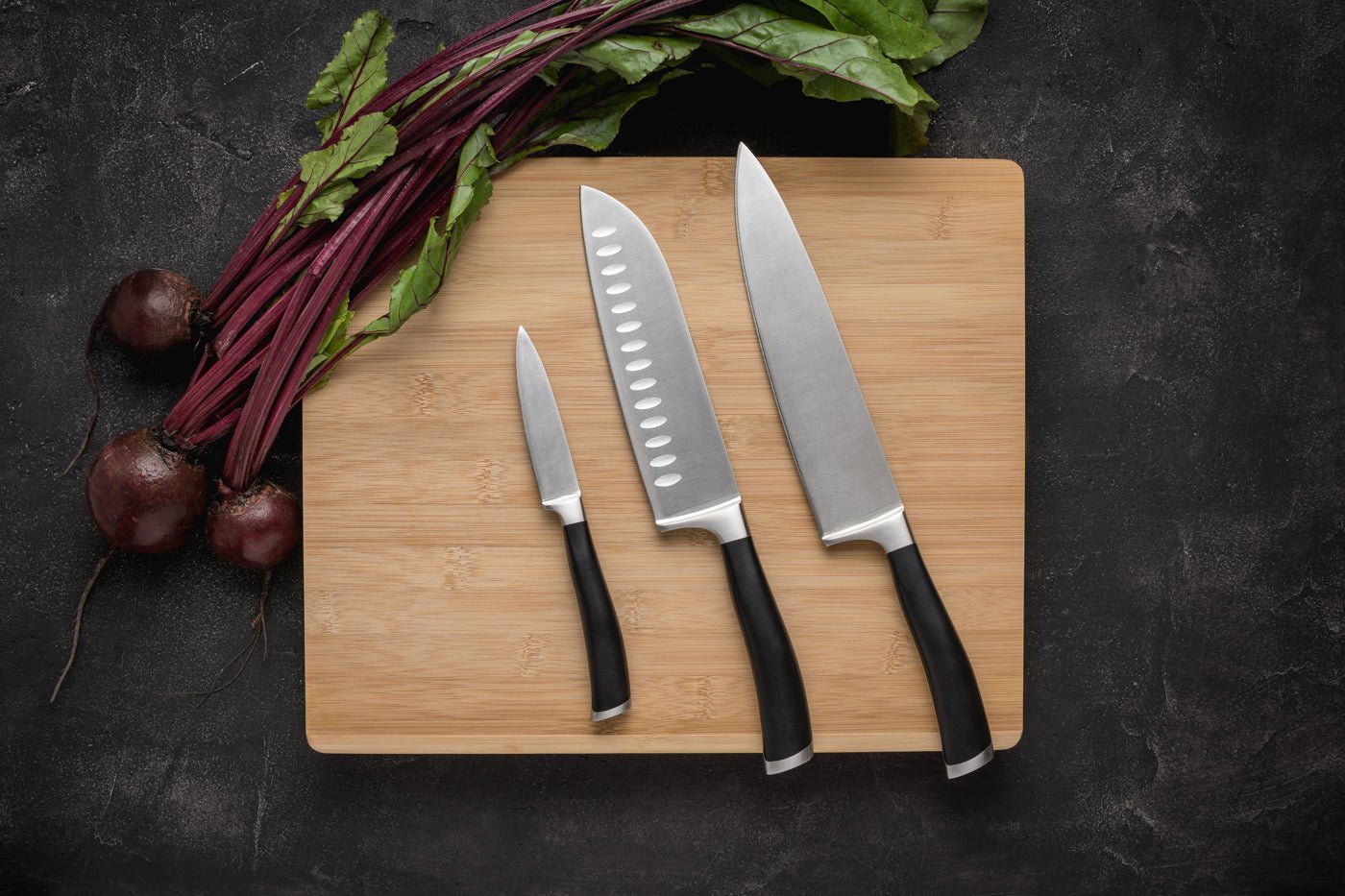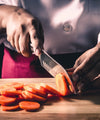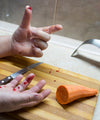Recent Post
Archive
- November 2021
-
- How to choose the right kitchen knife for the right chopping job.
- How to help reduce 60,000 knife accidents a year in the kitchen!
- HELPING THE EARTH – Why Bamboo chopping boards are the best?
- What is the BEST kitchen chopping board type?
- The Best Kitchen Knives & Why?
- Save Money – On GREAT kitchen knives
- October 2021
Tags
Custom Menu

The Best Kitchen Knives & Why?
We have cut, chopped, sliced and diced our way through heaps of meats and vegetables to find the best kitchen knives.
A GREAT KNIFE is the foundation on which any great meal is built, but in all probability, if you ask three chefs what makes a great knife, you'll more than likely get at lots of different answers.
The truth and reality are that what makes a great kitchen knife for you and me will depend on many factors, including our comfort level with knives, the size of our hands, and what sort of food we like to cook.
We believe the 7 to 10-inch knife is the most versatile knife in any kitchen. They normally come in 2 formats, ‘Chef’ knife and ‘Santoku’ knife and both are very capable of most tasks in the kitchen, from dicing veggies, slicing meat, smashing garlic, chopping herbs and nuts, filleting fish, and, even at a push, they will go through small bones without too much trouble.
SO, what makes a GREAT kitchen knife?
Without doubt, the type of BLADE steel is Number 1 in a GREAT kitchen knife…
The super cheap CHEF knives being described as ‘wonder knives’ – will most probably have a low-quality steel blade that will blunt easily and may even rust.
The mind numbingly super expensive CHEF knives – will most probably have a very High-quality steel blade.
Hear we look at the list of qualities to look for when buying a kitchen knife.
Stainless Steel
Most kitchen knives use stainless steel for the blades, mainly because it requires the least amount of knowledge, skill, and maintenance to keep them in good condition. Steel can only be classed as “stainless” if it has at least 10% chromium, which makes it both corrosion and rust resistant. The average home chef probably shouldn’t have a knife that will rust easily, so stainless is a good choice.
Blade Hardness
Hugely important, and the type of steel used in the blade effects hardness.
Blade hardness is the blade’s ability to resist permanent deformations. Typically, the harder the steel, the sharper you can get the edge and the longer it will remain sharp.
Hardness is measured using a Rockwell Hardness Test and its value is reported in HRC (Hardness Rockwell C scale). The higher the number, the harder the steel. In kitchen knives, the range is somewhere between HRC 50 and HRC 65.
Steel Type: Japanese Steel
Japanese knives typically use very hard steels (HRC 60+). This is what gives them the ability to sharpen the blades to a much sharper angle and helps them retain the edge longer than a German-style knife.
So, does this mean Japanese knives are automatically better than German knives since they’re harder? The answer is NO…
With hardness can come brittleness. And, while hardness in knives is good, a blade that’s brittle can chip if cutting into other hard objects like bone, so precautions must be taken.
Steel Type: German Steel
For this brittleness reason, the German steel choose a different balance between hardness, durability, and corrosion resistance. German steel is still very hard (HRC 56-58) By using less carbon and more of the other elements in the Japanese steel, their knives are sharpened to a shallower angle, they may need to be sharpened more often, however, on the other hand, they are very heavy-duty, robust, and durable against damage.
Knife Steel Comparison: Which is the best steel?
There is no universal “perfect” knife steel. They all just have a slightly different balance between hardness, durability, corrosion and wear resistance, visual appeal, and overall cost.
The best knife steel really comes down to who’s using the knife and what’s more important to them. Is it hardness and sharpness or is it low maintenance and less worries of damaging your knives? Performance versus price is also a common consideration.
Our opinion is either,
Japanese Steel Type: VG-10 or VG-MAX (which is basically equivalent to VG-10) (HRC 60+)
They both have great performance characteristics and are highly considered “the standards”.
OR
German Steel Type: German DIN 1.4116. / 4116 Krupp (aka - X50CrMoV15) (HRC 56-58)
When it comes to Western-style knives, German steels are KING.
German steel does a fantastic job in any kitchen, think heavy duty and rust-free.
German DIN 1.4116 and 4116 Krupp is probably the most common among HIGH QUALITY knife makers, and probably the best option for the widest range of users.
One of the finest stainless steels produced in Europe, and is created to very precise standards. knives made with steel have created legends.
It is more stain resistant than cheaper steel, is very low maintenance, and is much more heavy-duty.
It is a great compromise between rust resistance, toughness, edge retention and cost.
Great companies like J. A. Henckels, Sabatier, Wustof and Chop-Master, have all made some very famous chefs’ knives from this steel.
What to look for in a great kitchen knife?
1) Blade Steel Type – Covered above
2) Grip - Once you’ve got a knife in your hand you should get an instant sense of its fit. The knife should feel nice and comfortable, it should feel a natural extension of your hand. This should inspire confidence, and take way fear of using it.
3) Weight & Balance – Some believe a heavy chef’s knife cuts through foods easier, as it uses more force. Others think a lighter chef’s knife will flow more freely enabling you to manoeuvre the knife more skilfully. The reality is: Choose the weight of knife that feels just right to you.
4) Size – A 7-to-10-inch blade is the most popular among home cooks because of its versatility.
The best type of 7-to-10 -inch knife?
Santoku knife OR Chef Knife?
There are normally just 2 types of ‘go to’ knives, the ‘Santoku’ knife or the ‘Chef’ knife
Santoku knives and chef’s knives are the ‘go-to’ knives for many professional chefs as they are versatile enough to perform a range of tasks in the kitchen.
The main difference between a santoku knife and a chef's knife is that santoku knives are better suited to precision cutting, where you need really thin cuts. It's harder to achieve the same level of precision with a chef's knife.
What’s the difference?
The top knife = Chef Knife
The bottom knife = Santoku knife

Santoku Knife
Santoku knives are the Japanese version of the chef’s knife.
A Santoku knife normally has a shorter and wider blade than a chef knife.
In addition, the Santoku is lighter than its European brother which makes the Santoku very popular.
With a blade length of 7 to 8 inches it is most popular for all general work in the kitchen, including precision cutting, where you need really thin cuts.
The Santoku also benefits from a hollow edge on the blade, which creates pockets of air which in turn prevents extra thin or soft slices of food from sticking to the blade.
Chef Knife
A chef knife normally has a longer blade than a Santoku knife.
It is a very popular all arounder knife in the kitchen. It is particularly well designed for general cutting and chopping.
With a blade length of 8 to 10 inches it is most popular for general work, larger knives are for heavy cutting and chopping and the smaller blades are for more delicate work.
French or German style chef’s knives have a curved edge which gives the blade a rocking motion when chopping against a board and the long blade is also capable of slicing through meat.
Our choice, Santoku Knife or Chef knife?
We prefer the Santoku knife as it’s lighter, less food sticks to the blade and it brilliant at really thin cuts.
Kitchen knife - Selling Prices in the UK?
There is a lot of ‘smoke and mirrors’ in the kitchen CHEF & SANTOKU knife SELLING PRICE market!
Here we try and ‘blow that smoke away’ and ‘clean the mirrors!’
The ‘smoke and mirrors’ sees super cheap kitchen knives being described as ‘wonder knives’
The ‘smoke and mirrors’ continues with mind numbingly super expensive kitchen knives being available…
Leaving us all to ask - will the cheap ‘wonder knives’ actually be that good and compete with the ‘super expensive’ alternative?
OR
Will the ‘super expensive’ CHEF knives be so, so much better that the huge price tag is worth it?
Hopefully the following will help, PARTICULARLY if you are buying ON-LINE.
Quality and Price - The best knives available in the UK?
With all things considered, we believe the BEST knives available in the UK are the Chop-Master ‘Ultimate’ knives www.chop-master.com
A brilliant combination - Japanese style knives with premium German steel DIN 1.4116 blades.
• THE ULTIMATE KITCHEN KNIFE DESIGN – The Chop-Master™ ‘ULTIMATE’ Knives - Japanese Style and manufactured from PREMIUM German DIN 1.4116 Steel
• ULTIMATE QUALITY & ULTIMATE VALUE – The Chop-Master ‘ULTIMATE’ Knives offers you a quality of knife with unsurpassed value in the market – Chop-Master™ ‘ULTIMATE’ Kitchen Knives are in a Quality & Value Class of their Own!
• ULTIMATE PERFORMANCE - All the benefits of the top Japanese knives – constructed for razor-sharp performance and a heavy focus on Endurance.
• PREMIUM GERMAN DIN 1.4116 STEEL BLADES – With a 7-inch Japanese style blade with a Rockwell Hardness of HRC 56 – 58 and a 15-degree cutting angle.
• CLASSIC TRIPLE RIVETED NATURAL SANDALWOOD HANDLE – Graceful and ergonomic offering ULTIMATE Performance – super-strong design with a Full Tang Handle – ULTIMATE comfort design which encourages the Chef’s pinch grip style of Cutting - Perfect Balance.
Superb quality at brilliant prices when compared ‘like for like’ with Wusthof and Henckels.
https://www.chop-master.com/products/chop-master-ultimate-chef-knives
← Older Post Newer Post →








